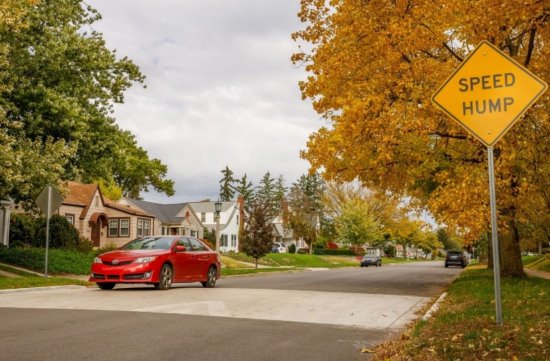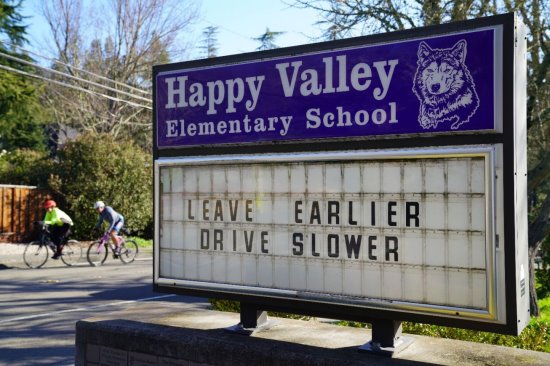 |
|
|
Speed humps help to reduce speeding on neighborhood streets. Photo courtesy City of Lafayette
|
|
|
|
|
|
The City of Lafayette Traffic Calming Program has been designed to help manage speed-related traffic concerns along local and collector streets across the city, according to Patrick Golier, Lafayette's Transportation & Circulation Program Manager. Lafayette's existing Traffic Calming Program, adopted in March 2003, has been paused for approximately a year as the planning process for the City's Local Road Safety Plan (LRSP) has been underway.
 Golier on June 26 presented the city council with an updated Traffic Calming Program Guidebook to be utilized by Lafayette residents interested in pursuing traffic calming measures in their neighborhoods. The intent of the updated program is that it be aligned with the direction of the LRSP.
Golier on June 26 presented the city council with an updated Traffic Calming Program Guidebook to be utilized by Lafayette residents interested in pursuing traffic calming measures in their neighborhoods. The intent of the updated program is that it be aligned with the direction of the LRSP.
 According to the staff report, "The current process is complex, requires significant time of city staff as well as members of the community, results in long time horizons for project delivery, and does not articulate the metrics that are used to evaluate requests for traffic calming intervention in a neighborhood or on a street."
According to the staff report, "The current process is complex, requires significant time of city staff as well as members of the community, results in long time horizons for project delivery, and does not articulate the metrics that are used to evaluate requests for traffic calming intervention in a neighborhood or on a street."
 Golier explained that the 2023 City of Lafayette's Traffic Calming Program remains a resident-driven, application-based program that addresses speeding on local (residential) and collector streets in Lafayette. "This is as opposed to more proactive transportation initiatives such as our Safe Routes to School efforts and implementation of projects identified in the City's Bikeways and Walkways Master Plans," he noted.
Golier explained that the 2023 City of Lafayette's Traffic Calming Program remains a resident-driven, application-based program that addresses speeding on local (residential) and collector streets in Lafayette. "This is as opposed to more proactive transportation initiatives such as our Safe Routes to School efforts and implementation of projects identified in the City's Bikeways and Walkways Master Plans," he noted.
 The intent of the updated program is to address funding availability, ensure community support for traffic calming measures proposed on neighborhood streets, as well as data supporting any requests, and reflect a realistic availability of staff time to execute the program.
The intent of the updated program is to address funding availability, ensure community support for traffic calming measures proposed on neighborhood streets, as well as data supporting any requests, and reflect a realistic availability of staff time to execute the program.
 One of the main changes to the process includes an annual deadline for applications of Sept. 30.
One of the main changes to the process includes an annual deadline for applications of Sept. 30.
 "This new timeline reflects that the updated program will be managed on an annual cycle, rather than accepting applications on a rolling basis as is the current practice," Golier noted in his report.
"This new timeline reflects that the updated program will be managed on an annual cycle, rather than accepting applications on a rolling basis as is the current practice," Golier noted in his report.
 According to Golier, the city receives approximately 12-15 applications per year. Council Member Wei-Tai Kwok asked with the new deadline of Sept. 30 if all the applications would be processed together and if that "bulk processing" is helpful to the staff.
According to Golier, the city receives approximately 12-15 applications per year. Council Member Wei-Tai Kwok asked with the new deadline of Sept. 30 if all the applications would be processed together and if that "bulk processing" is helpful to the staff.
 "For staff time, it's easier to evaluate everything at once," Golier said. "To have one set of data collection, one kind of intensive [review] to compare them all, I know I have `x' amount of funding available, so it's easier to prioritize, to rank and it's much more transparent to residents as well and they get feedback sooner." All applications received thus far will be required to follow the new standards, and the city will reach out to those applicants with information.
"For staff time, it's easier to evaluate everything at once," Golier said. "To have one set of data collection, one kind of intensive [review] to compare them all, I know I have `x' amount of funding available, so it's easier to prioritize, to rank and it's much more transparent to residents as well and they get feedback sooner." All applications received thus far will be required to follow the new standards, and the city will reach out to those applicants with information.
 In addition to streamlining the approach to handling neighborhood traffic calming requests, the updated Guidebook is intended to align with the city's overarching Vison Zero goal to eliminate traffic-related collisions that result in serious injuries and fatalities, as well as with the Lafayette Local Road Safety Plan, which supports projects and programs that go beyond traffic calming to address safety in Lafayette.
In addition to streamlining the approach to handling neighborhood traffic calming requests, the updated Guidebook is intended to align with the city's overarching Vison Zero goal to eliminate traffic-related collisions that result in serious injuries and fatalities, as well as with the Lafayette Local Road Safety Plan, which supports projects and programs that go beyond traffic calming to address safety in Lafayette.
 According to the Guidebook, this program "does not replace a resident's ability to contact the city about maintenance or other issues that do not fit the definition of `traffic calming.'" These requests can be addressed by submitting a Transportation Action Request form or calling the Engineering Department at (925)284-1951.
According to the Guidebook, this program "does not replace a resident's ability to contact the city about maintenance or other issues that do not fit the definition of `traffic calming.'" These requests can be addressed by submitting a Transportation Action Request form or calling the Engineering Department at (925)284-1951.
 City council members unanimously voted to adopt the updated Traffic Calming Program, offering their thanks to Golier and Placeworks, which has been working with Golier to update the Traffic Calming Plan.
City council members unanimously voted to adopt the updated Traffic Calming Program, offering their thanks to Golier and Placeworks, which has been working with Golier to update the Traffic Calming Plan.
 City Manager Niroop Srivatsa also thanked Golier for his work, noting, "This is huge. With all of Patrick's experience, this document will be put to good use."
City Manager Niroop Srivatsa also thanked Golier for his work, noting, "This is huge. With all of Patrick's experience, this document will be put to good use."
|

